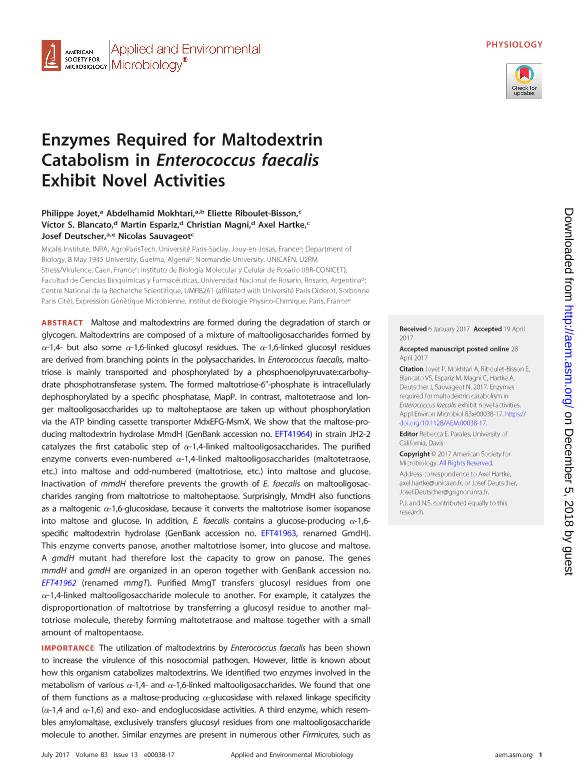Mostrar el registro sencillo del ítem
dc.contributor.author
Joyet, Philippe
dc.contributor.author
Mokhtari, Abdelhamid
dc.contributor.author
Riboulet-Bisson, Eliette
dc.contributor.author
Blancato, Victor Sebastian

dc.contributor.author
Espariz, Martin

dc.contributor.author
Magni, Christian

dc.contributor.author
Hartke, Axel
dc.contributor.author
Deutscher, Josef
dc.contributor.author
Sauvageot, Nicolas
dc.date.available
2018-12-05T18:51:25Z
dc.date.issued
2017-07
dc.identifier.citation
Joyet, Philippe; Mokhtari, Abdelhamid; Riboulet-Bisson, Eliette; Blancato, Victor Sebastian; Espariz, Martin; et al.; Enzymes required for maltodextrin catabolism in Enterococcus faecalis exhibit novel activities; American Society for Microbiology; Applied And Environmental Microbiology; 83; 13; 7-2017
dc.identifier.issn
0099-2240
dc.identifier.uri
http://hdl.handle.net/11336/65903
dc.description.abstract
Maltose and maltodextrins are formed during the degradation of starch or glycogen. Maltodextrins are composed of a mixture of maltooligosaccharides formed by α-1,4- but also some α-1,6-linked glucosyl residues. The α-1,6-linked glucosyl residues are derived from branching points in the polysaccharides. In Enterococcus faecalis, maltotriose is mainly transported and phosphorylated by a phosphoenolpyruvate:carbohydrate phosphotransferase system. The formed maltotriose-6α-phosphate is intracellularly dephosphorylated by a specific phosphatase, MapP. In contrast, maltotetraose and longer maltooligosaccharides up to maltoheptaose are taken up without phosphorylation via the ATP binding cassette transporter MdxEFG-MsmX. We show that the maltose-producing maltodextrin hydrolase MmdH (GenBank accession no. EFT41964) in strain JH2-2 catalyzes the first catabolic step of α-1,4-linked maltooligosaccharides. The purified enzyme converts even-numbered α-1,4-linked maltooligosaccharides (maltotetraose, etc.) into maltose and odd-numbered (maltotriose, etc.) into maltose and glucose. Inactivation of mmdH therefore prevents the growth of E. faecalis on maltooligosaccharides ranging from maltotriose to maltoheptaose. Surprisingly, MmdH also functions as a maltogenic α-1,6-glucosidase, because it converts the maltotriose isomer isopanose into maltose and glucose. In addition, E. faecalis contains a glucose-producing α-1,6- specific maltodextrin hydrolase (GenBank accession no. EFT41963, renamed GmdH). This enzyme converts panose, another maltotriose isomer, into glucose and maltose. A gmdH mutant had therefore lost the capacity to grow on panose. The genes mmdH and gmdH are organized in an operon together with GenBank accession no. EFT41962 (renamed mmgT). Purified MmgT transfers glucosyl residues from one α-1,4-linked maltooligosaccharide molecule to another. For example, it catalyzes the disproportionation of maltotriose by transferring a glucosyl residue to another maltotriose molecule, thereby forming maltotetraose and maltose together with a small amount of maltopentaose.
dc.format
application/pdf
dc.language.iso
eng
dc.publisher
American Society for Microbiology

dc.rights
info:eu-repo/semantics/openAccess
dc.rights.uri
https://creativecommons.org/licenses/by-nc-sa/2.5/ar/
dc.subject
Enterococcus Faecalis
dc.subject
Glucosyl Transferase
dc.subject
Maltodextrin Catabolism
dc.subject
Α-1,4-Glucosidase
dc.subject
Α-1,6-Glucosidase
dc.subject.classification
Otras Ciencias Biológicas

dc.subject.classification
Ciencias Biológicas

dc.subject.classification
CIENCIAS NATURALES Y EXACTAS

dc.title
Enzymes required for maltodextrin catabolism in Enterococcus faecalis exhibit novel activities
dc.type
info:eu-repo/semantics/article
dc.type
info:ar-repo/semantics/artículo
dc.type
info:eu-repo/semantics/publishedVersion
dc.date.updated
2018-10-23T17:33:27Z
dc.journal.volume
83
dc.journal.number
13
dc.journal.pais
Estados Unidos

dc.journal.ciudad
Washington
dc.description.fil
Fil: Joyet, Philippe. Université Paris-Saclay; Francia
dc.description.fil
Fil: Mokhtari, Abdelhamid. Université Paris-Saclay; Francia. 8 May 1945 University; Argelia
dc.description.fil
Fil: Riboulet-Bisson, Eliette. Normandie University; Francia
dc.description.fil
Fil: Blancato, Victor Sebastian. Consejo Nacional de Investigaciones Científicas y Técnicas. Centro Científico Tecnológico Conicet - Rosario. Instituto de Biología Molecular y Celular de Rosario. Universidad Nacional de Rosario. Facultad de Ciencias Bioquímicas y Farmacéuticas. Instituto de Biología Molecular y Celular de Rosario; Argentina
dc.description.fil
Fil: Espariz, Martin. Consejo Nacional de Investigaciones Científicas y Técnicas. Centro Científico Tecnológico Conicet - Rosario. Instituto de Biología Molecular y Celular de Rosario. Universidad Nacional de Rosario. Facultad de Ciencias Bioquímicas y Farmacéuticas. Instituto de Biología Molecular y Celular de Rosario; Argentina
dc.description.fil
Fil: Magni, Christian. Consejo Nacional de Investigaciones Científicas y Técnicas. Centro Científico Tecnológico Conicet - Rosario. Instituto de Biología Molecular y Celular de Rosario. Universidad Nacional de Rosario. Facultad de Ciencias Bioquímicas y Farmacéuticas. Instituto de Biología Molecular y Celular de Rosario; Argentina
dc.description.fil
Fil: Hartke, Axel. Normandie University; Francia
dc.description.fil
Fil: Deutscher, Josef. Université Paris-Saclay; Francia. Centre National de la Recherche Scientifique; Francia
dc.description.fil
Fil: Sauvageot, Nicolas. Normandie University; Francia
dc.journal.title
Applied And Environmental Microbiology

dc.relation.alternativeid
info:eu-repo/semantics/altIdentifier/doi/https://dx.doi.org/10.1128/AEM.00038-17
dc.relation.alternativeid
info:eu-repo/semantics/altIdentifier/url/https://aem.asm.org/content/83/13/e00038-17
Archivos asociados
